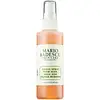What's inside
What's inside
 Key Ingredients
Key Ingredients

No key ingredients
 Benefits
Benefits

 Concerns
Concerns

 Ingredients Side-by-side
Ingredients Side-by-side

Water
Skin ConditioningPropylene Glycol
HumectantSalvia Officinalis Flower/Leaf/Stem Water
MaskingCitrus Aurantium Amara Flower Water
MaskingThymus Vulgaris Leaf Extract
Skin ProtectingSalvia Officinalis Leaf Extract
CleansingAloe Barbadensis Leaf Juice
Skin ConditioningFucus Vesiculosus Extract
EmollientPropanediol
SolventEthylhexylglycerin
Skin ConditioningBenzophenone-4
UV AbsorberParfum
MaskingSodium Chloride
MaskingCitric Acid
BufferingPotassium Sorbate
PreservativeSodium Benzoate
MaskingHexyl Cinnamal
PerfumingLimonene
PerfumingLinalool
PerfumingCI 16035
Cosmetic ColorantCI 19140
Cosmetic ColorantCI 15985
Cosmetic ColorantWater, Propylene Glycol, Salvia Officinalis Flower/Leaf/Stem Water, Citrus Aurantium Amara Flower Water, Thymus Vulgaris Leaf Extract, Salvia Officinalis Leaf Extract, Aloe Barbadensis Leaf Juice, Fucus Vesiculosus Extract, Propanediol, Ethylhexylglycerin, Benzophenone-4, Parfum, Sodium Chloride, Citric Acid, Potassium Sorbate, Sodium Benzoate, Hexyl Cinnamal, Limonene, Linalool, CI 16035, CI 19140, CI 15985
Water
Skin ConditioningGlycerin
HumectantTrideceth-9
EmulsifyingPEG-40 Hydrogenated Castor Oil
EmulsifyingSodium PCA
HumectantPhenoxyethanol
PreservativeParfum
MaskingRosa Damascena Flower Water
MaskingPropylene Glycol
HumectantButylene Glycol
HumectantTocopheryl Acetate
AntioxidantEthylhexylglycerin
Skin ConditioningAloe Barbadensis Leaf Extract
EmollientDehydroacetic Acid
PreservativeEcklonia Cava Extract
Skin ConditioningHizikia Fusiforme Extract
Skin ConditioningCodium Tomentosum Extract
Skin ProtectingGelidium Cartilagineum Extract
Skin ProtectingBenzyl Alcohol
PerfumingBenzyl Salicylate
PerfumingButylphenyl Methylpropional
PerfumingHexyl Cinnamal
PerfumingLinalool
PerfumingLimonene
PerfumingGeraniol
PerfumingWater, Glycerin, Trideceth-9, PEG-40 Hydrogenated Castor Oil, Sodium PCA, Phenoxyethanol, Parfum, Rosa Damascena Flower Water, Propylene Glycol, Butylene Glycol, Tocopheryl Acetate, Ethylhexylglycerin, Aloe Barbadensis Leaf Extract, Dehydroacetic Acid, Ecklonia Cava Extract, Hizikia Fusiforme Extract, Codium Tomentosum Extract, Gelidium Cartilagineum Extract, Benzyl Alcohol, Benzyl Salicylate, Butylphenyl Methylpropional, Hexyl Cinnamal, Linalool, Limonene, Geraniol
 Reviews
Reviews

Ingredients Explained
These ingredients are found in both products.
Ingredients higher up in an ingredient list are typically present in a larger amount.
Ethylhexylglycerin (we can't pronounce this either) is commonly used as a preservative and skin softener. It is derived from glyceryl.
You might see Ethylhexylglycerin often paired with other preservatives such as phenoxyethanol. Ethylhexylglycerin has been found to increase the effectiveness of these other preservatives.
Hexyl Cinnamal is a fragrance ingredient with a similar scent to jasmine. It can be naturally found in chamomile essential oil.
This ingredient is a known EU allergen and may sensitize the skin. The EU requires this ingredient to be listed separately on an ingredients list.
Hexyl Cinnamal is not water soluble but is soluble in oils.
Learn more about Hexyl CinnamalLimonene is a fragrance that adds scent and taste to a formulation.
It's found in the peel oil of citrus fruits and other plants such as lavender and eucalyptus. The scent of limonene is generally described as "sweet citrus".
Limonene acts as an antioxidant, meaning it helps neutralize free radicals.
When exposed to air, oxidized limonene may sensitize the skin. Because of this, limonene is often avoided by people with sensitive skin.
The term 'fragrance' is not regulated in many countries. In many cases, it is up to the brand to define this term. For instance, many brands choose to label themselves as "fragrance-free" because they are not using synthetic fragrances. However, their products may still contain ingredients such as essential oils that are considered a fragrance.
Learn more about LimoneneLinalool is a fragrance and helps add scent to products. It's derived from common plants such as cinnamon, mint, citrus, and lavender.
Like Limonene, this ingredient oxidizes when exposed to air. Oxidized linalool can cause allergies and skin sensitivity.
This ingredient has a scent that is floral, spicy tropical, and citrus-like.
Learn more about LinaloolParfum is a catch-all term for an ingredient or more that is used to give a scent to products.
Also called "fragrance", this ingredient can be a blend of hundreds of chemicals or plant oils. This means every product with "fragrance" or "parfum" in the ingredients list is a different mixture.
For instance, Habanolide is a proprietary trade name for a specific aroma chemical. When used as a fragrance ingredient in cosmetics, most aroma chemicals fall under the broad labeling category of “FRAGRANCE” or “PARFUM” according to EU and US regulations.
The term 'parfum' or 'fragrance' is not regulated in many countries. In many cases, it is up to the brand to define this term.
For instance, many brands choose to label themselves as "fragrance-free" because they are not using synthetic fragrances. However, their products may still contain ingredients such as essential oils that are considered a fragrance by INCI standards.
One example is Calendula flower extract. Calendula is an essential oil that still imparts a scent or 'fragrance'.
Depending on the blend, the ingredients in the mixture can cause allergies and sensitivities on the skin. Some ingredients that are known EU allergens include linalool and citronellol.
Parfum can also be used to mask or cover an unpleasant scent.
The bottom line is: not all fragrances/parfum/ingredients are created equally. If you are worried about fragrances, we recommend taking a closer look at an ingredient. And of course, we always recommend speaking with a professional.
Learn more about ParfumPropylene Glycol is an odorless, colorless liquid. As a humectant, it helps skin retain moisture. It also aids in delivering active ingredients.
Another role of this ingredient is preventing a product from melting or freezing. Propylene glycol also adds antimicrobrial properties to a product, elongating product lifespan.
This ingredient is considered an organic alcohol and commonly added into both cosmetics and foods.
Those with sensitive skin or conditions may develop a rash when using this ingredient.
Learn more about Propylene GlycolWater. It's the most common cosmetic ingredient of all. You'll usually see it at the top of ingredient lists, meaning that it makes up the largest part of the product.
So why is it so popular? Water most often acts as a solvent - this means that it helps dissolve other ingredients into the formulation.
You'll also recognize water as that liquid we all need to stay alive. If you see this, drink a glass of water. Stay hydrated!
Learn more about Water